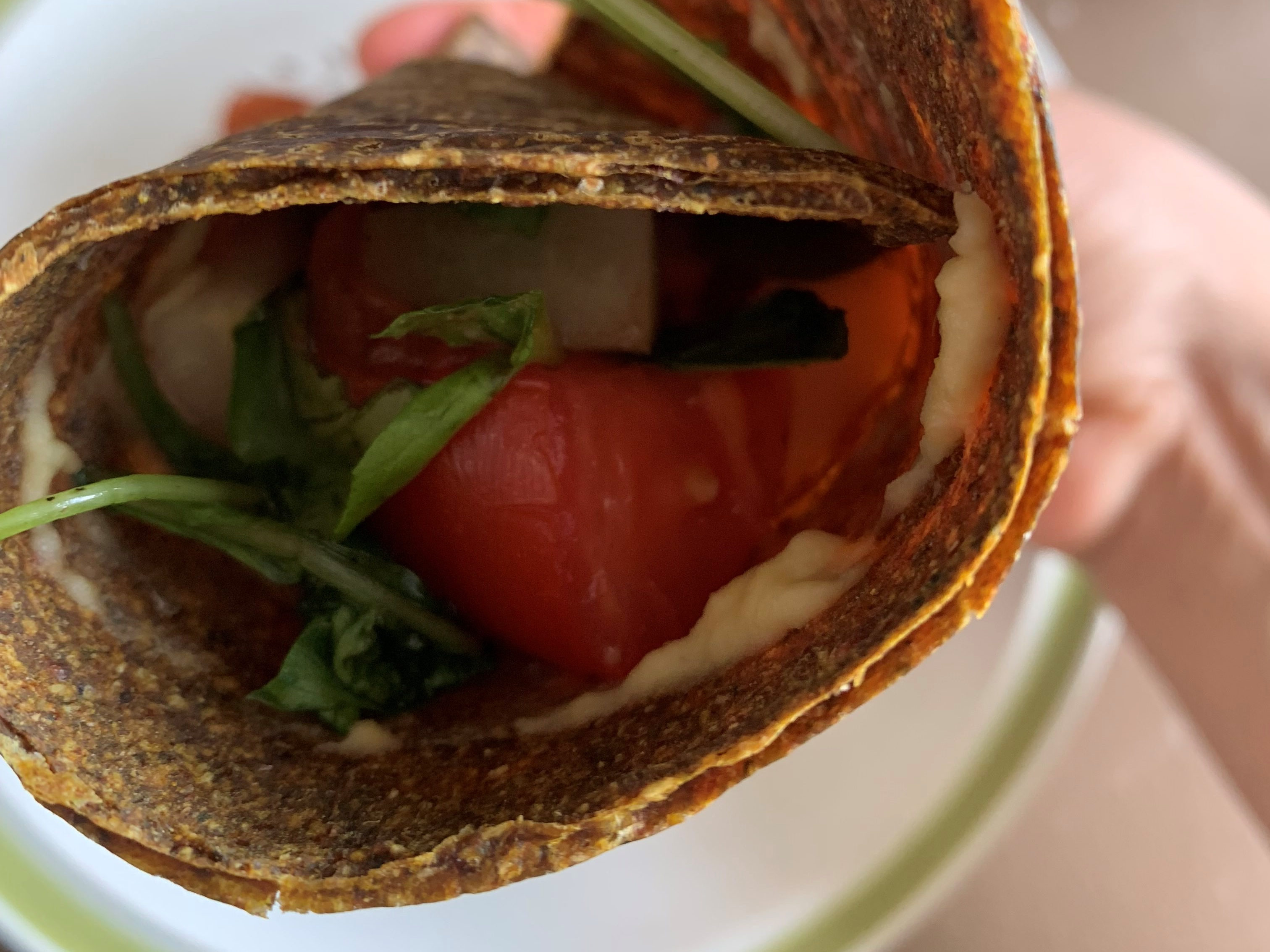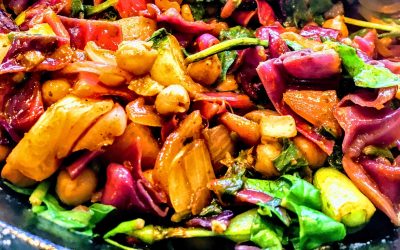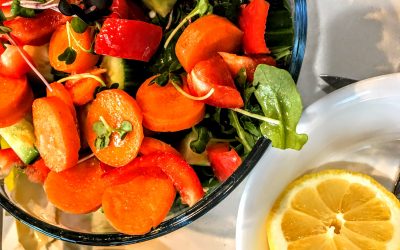Wrawp
It Good
An Eat The Rainbow Recipe
Wrawp It Good

Time
Prep: 10 Min
Cook: 0 Min
Ready-To-Eat: 10 Min
Diet
Vegan
Gluten Free
Grain Free
Makes
2 Large Wraps
Ingredients
- 2 Wrawps ~ Wrawp is the brand IN the blue package
- 1 tbsp – toasted sesame oil
- 1 stock – spanish onion
- 3 thin slices – goat mozzarella
- 1⁄2 medium – tomato
- 1 – chayote squash ~ can find at an “ethnic” supermarket, or use your zucchini instead
- 1 handful – greens ~ kale, and arugula combo
- 1 handful – cilantro
- 1 handful – mushrooms ~ I used chanterelles
- 2 tsps Kalamata olive hummus by Summer Fresh
- Dash – garlic powder
- Dash – himalayan salt
- Splash – salad dressing ~ I used Okanagan little creek cesear salad: it is
- Splash – Hot sauce: Valentina’s hot sauce ~ TECHNICALLY NOT gluten free due to the Tamari, but is NOT gluten free a SUPER small amount, so as someone who is sensitive but not celiac I use it sparingly)
Instructions
Step 1:
Add 1 tsp each to the wrawp
Step 2:
On top of the humus put 1.5 pieces of thinly sliced goat mozzarella
Step 3:
Preheat oven at 170 °
Step 4:
Meanwhile, at medium heat in pan: add tbsp of roasted sesame oil on pan, use a brush to lather in pan evenly
Step 5:
Add the sliced chayote squash in pan
Step 6:
After 1 mins add mushrooms and diced spanich onion
Step 7:
Then after mixed up, add sliced tomato
Step 8:
Lastly add the handful of greens to pan
Step 9:
Mix all ingredients and turn off pan. At this point, pull the wrawp out of the oven. Add the ingredients from the pan onto the wrawps.
Step 10:
As to taste, you can add a dash of himilayan salt, and sprinkle salad dressing, and/or hot sauce
Nutritional Benefits
Chayote Squash
This promotes blood sugar control, it is low in calories, fat, and total carbs. It is high in potent antioxidants: that protect against cellular damage, reduce inflammation, and lower stress within your body.
Wrawp
Made gluten and grain free, since it is made from organic fruits and veggies therefore is rich in vitamins and minerals from the organic fruits and veggies.
Goat Cheese
A protein source, that is NOT the same as dairy from cow as it DOES NOT contain casein, the enzyme most often people are sensitive too who have allergies or sensitivities to cow dairy. Provides healthy fats; which also can keep you fuller longer. Also compared to cow’s milk, goat’s milk has a higher proportion of medium-chain fatty acids (MCFAs), which include: caproic acid, caprylic acid and capric acid.
More “Eat The Rainbow” Recipes
Subscribe Today for Access to All of My Recipes
Quick & Easy Veggie Stir Fry
Quick & EasyVeggie Stir FryAn Eat The Rainbow RecipePrep: 10 Min Cook: 10 Min Ready-To-Eat: 20 MinVegan Gluten Free Grain Free5 Full BowlsIngredients 1⁄2 jar - Patak’s Madras Curry Paste 1 small jar - artichoke hearts 1 - onion 1 - yellow pepper 1 - red cabbage 1...
Alive Simple Salad
AliveSimple SaladAn Eat The Rainbow RecipePrep: 5 Min Cook: 0 Min Ready-To-Eat: 5 MinVegan Gluten Free Grain Free2 Full BowlsIngredients 1-2 whole - Carrots 1 - Red pepper 1/2 - cucumber 1 handful - arugula 1 handful - spinach 1 handful - sunflower sprouts 1⁄2 - fresh...
Eating Raw Food
By Evi Spiliotopoulos
There are different schools of thought in regards to the nutritional value of eating food raw, or cooked. From my CSNN nutrition school, it was expressed from numerous sources that a traditional nutritionist standpoint is most often said for most people to find optimal health it is advised: to eat 70% raw and 30% cooked, steamed, or stir fried food. It is believed that the raw foods provide more enzymes in their raw food states.
However, with my BA major being: anthropology, I like to look at what different cultures do, and have done: in regards to optimal health. That which aligns with OurOM2hands values of being: holistic, sustainable and abundant intentions and actions. SO the two oldest most recognized forms of holistic, sustainable, abundant health seem to be: Ayurveda and TCM/traditional chinese medicine.
A close friend of mine (who is interviewed here on my vlog) states raw food is not for everyone, and may also depend on the season! Since most of us in the summer crave and want to eat more raw fruits and veggies, whereas depending WHERE you live; often in colder wintery weather more cooked or steamed root veggies are craved and wanted by the body. Have you noticed this?


I like to eat steamed or lightly stir fried food most often, especially in cooler temperatures. Although I do love raw fruit, and some simple salads like the one in recipe 1 of this Eat the Rainbow section. I find in general from warm foods: mentally, emotionally I feel overall more grounded and calm. My body also when it eats some warm cooked or steamed food, does not crave more food as I feel satisfied. When I personally eat a lot of raw food or the 70/30 ratio: I often including in warmer weather: find my digestion slows down and I feel overall more sluggish and/or mentally/emotionally spacy.
It is a personal journey to find, or rediscover WHICH foods feed you. This includes the holistic: physical/mental/emotional. Sustainable: easy to access, and prep and/or make. Abundant: brings you joy, and nourishment. As a registered holistic nutritionist I would advise if you are very confused: keep a food journal.
Food journal exercise
Keep a food journal for a minimum of one week. The food journal is a commitment to your health. This drive and discipline to optimal health may give you back in return an invaluable deepening into what YOU need which includes via food. It is an opportunity to delve into your holistic, sustainable, abundant intentions and actions ?

Advised: How to do the food journal experiment
Step 1:
It is recommended: write down each food you eat, for the duration of min one week.
Step 2:
Next, after EACH food and/or meal you eat: write down HOW you feel right after you eat
- Energy wise
- Emotionally does it do anything for you, what you just ate
- Mental clarity
- IF you notice anything about your digestion
Step 3:
Make another column in your food journal for HOW you feel 30mins AFTER you have eaten that specific food or meal. Keep in mind: The key is to leave as much room as you can to write your first and second impressions for each section. It is imperative you are open and honest with yourself on this journey, this process is all FOR YOU!
Step 4:
After the week is up, look back with a fine tooth combs, are there patterns?
Is they’re foods or meals your body seem to resonate with physically/mentally/emotionally? Was it to nourish you, or keep you stuck in a pattern of addiction (ie sugar)?



0 Comments